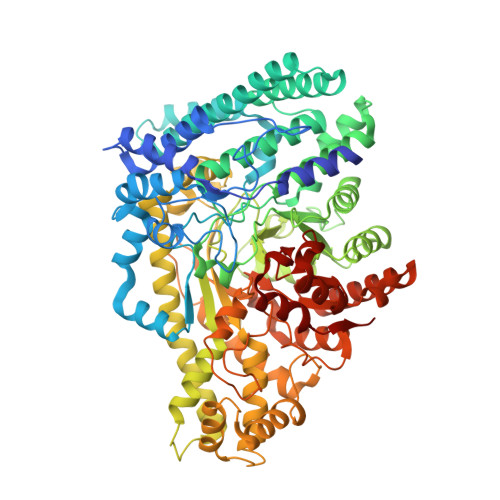A Widespread Radical-Mediated Glycolysis Pathway.
Ma, K., Xue, B., Chu, R., Zheng, Y., Sharma, S., Jiang, L., Hu, M., Xie, Y., Hu, Y., Tao, T., Zhou, Y., Liu, D., Li, Z., Yang, Q., Chen, Y., Wu, S., Tong, Y., Robinson, R.C., Yew, W.S., Jin, X., Liu, Y., Zhao, H., Ang, E.L., Wei, Y., Zhang, Y.(2024) J Am Chem Soc 146: 26187-26197
- PubMed: 39283600
- DOI: https://doi.org/10.1021/jacs.4c07718
- Primary Citation of Related Structures:
8ID0, 8ID7, 8YJN, 8YJO - PubMed Abstract:
Glycyl radical enzymes (GREs) catalyze mechanistically diverse radical-mediated reactions, playing important roles in the metabolism of anaerobic bacteria. The model bacterium Escherichia coli MG1655 contains two GREs of unknown function, YbiW and PflD, which are widespread among human intestinal bacteria. Here, we report that YbiW and PflD catalyze ring-opening C-O cleavage of 1,5-anhydroglucitol-6-phosphate (AG6P) and 1,5-anhydromannitol-6-phosphate (AM6P), respectively. The product of both enzymes, 1-deoxy-fructose-6-phosphate (DF6P), is then cleaved by the aldolases FsaA or FsaB to form glyceraldehyde-3-phosphate (G3P) and hydroxyacetone (HA), which are then reduced by the NADH-dependent dehydrogenase GldA to form 1,2-propanediol (1,2-PDO). Crystal structures of YbiW and PflD in complex with their substrates provided insights into the mechanism of radical-mediated C-O cleavage. This "anhydroglycolysis" pathway enables anaerobic growth of E. coli on 1,5-anhydroglucitol (AG) and 1,5-anhydromannitol (AM), and we probe the feasibility of harnessing this pathway for the production of 1,2-PDO, a highly demanded chiral chemical feedstock, from inexpensive starch. Discovery of the anhydroglycolysis pathway expands the known catalytic repertoire of GREs, clarifies the hitherto unknown physiological functions of the well-studied enzymes FsaA, FsaB, and GldA, and demonstrates how enzyme discovery efforts can cast light on prevalent yet overlooked metabolites in the microbiome.
Organizational Affiliation:
New Cornerstone Science Laboratory, School of Pharmaceutical Science and Technology, Tianjin University, Tianjin 300072, China.















